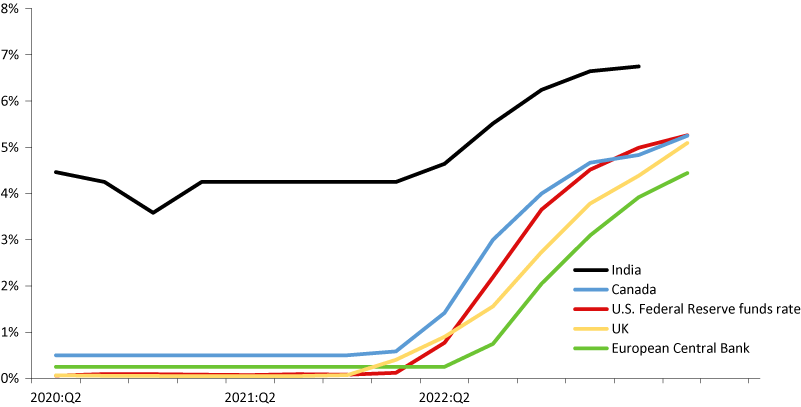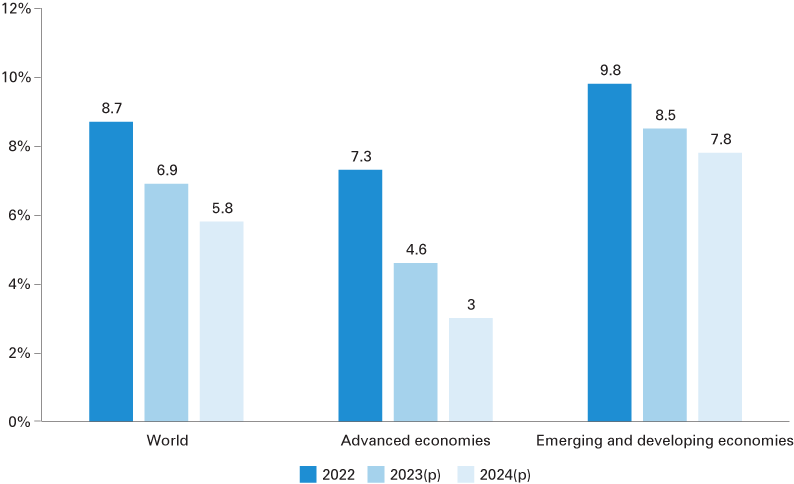
International outlook for 2024

Associate Professor, Kelley School of Business, Indiana University

Senior Lecturer, Kelley School of Business, Indiana University
Introduction
The international outlooks published in these pages over the last several years have come with a high degree of uncertainty. The international outlook for 2024 proves to be more of the same. What’s more is geopolitical risks abroad have only elevated, with the Russian war in Ukraine continuing and the potential for a large-scale conflict in the Middle East recently emerging. These conflicts will play out against the backdrop of many countries still facing challenges with above-normal inflation and lowered prospects for growth in economic activity.
Inflationary pressures, which have been more pervasive and persistent than many initially expected, have also led to a substantial shift in monetary policy. Increases in interest rates have been the norm in most parts of the world over the last 18 months (see Figure 1). These policy responses have led to slowdowns in economic activity in certain sectors (e.g., housing and technology) that are particularly sensitive to interest rates, in addition to putting added pressure on the cost of servicing debt for both governments and households alike.
Figure 1: Nominal interest rates for selected geographies

Source: Federal Reserve Economic Data, St. Louis Fed and authors’ calculations
To date, bolstered by a resilient consumer, most countries have seen growth moderate in 2023 but not contract, with a few notable exceptions like Germany. Moreover, if the progress on slowing down inflation continues into 2024 (see Figure 2), then many economies could be poised for a “soft landing” and avoid a recession.
Figure 2: Global inflation
Note: (p) indicates a projection.
Source: International Monetary Fund: World Economic Outlook, Table 1.1
The IMF expects growth in the global economy to continue into 2024 at a rate of 2.9%, coming off projected growth in 2023 of 3.0%. The outlook for growth in 2024 has become slightly more pessimistic over the last two quarters. Moreover, there appears to be more downside risk as the further development of geopolitical shocks (e.g., the wars in the Middle East and Ukraine) unsettle financial and energy markets, which could lead to significant challenges for the global economy going forward.
United States
Recent growth in the U.S. has surprised on the upside and is expected to come in at 2.1% for 2023. Growth in 2024 is expected to fall modestly and be at a rate of 1.5%, reflecting growth just below trend.
In terms of inflation, the U.S. economy has seen significant progress, but is still facing challenges. Latest readings of both total Consumer Price Index (CPI) and core CPI are coming in at year-over-year rates of 3.7% and 4.1%, respectively. The progress on bringing down inflation over the last year has left room for the possibility that the Federal Reserve might be done raising interest rates. However, there remains the real possibility that inflation remains persistent above target levels and the Fed has to leave interest rates higher for longer. Two other important aspects that could lead to headwinds on the U.S. economy include how the wars abroad (in Ukraine and the Middle East) impact energy prices and contribute to inflation, in addition to how the rise in interest rates have increased the cost of servicing debt both for the government and households. These added costs have already begun to show up in elevated delinquencies (e.g., for auto loans), and could begin to put strains on economic activity broadly.
So, while the U.S. economy has remained much stronger than perhaps many were expecting—perhaps most noticeably coming from a strong labor market—there remain signs that that resiliency could have limits.
Eurozone
The Eurozone is projected to grow 0.7% during 2023. This represents a much more dramatic slowdown than many other developed nations. Part of this slowdown comes from the Eurozone economies being more affected by the war in Ukraine.
Moreover, divergence in economic activity within the Eurozone has emerged due to a slowing of manufacturing at the same time services, especially tourism, saw a resurgence in 2023. Germany, a more manufacturing-based economy, is expected to contract by 0.5% at the end of 2023. In contrast, supported by the tourism sector, Spain and France are expected to grow in 2023 by 2.5% and 1.0%, respectively. And while inflation has come down throughout most of the Eurozone, the projected rate for 2023 still remains elevated at 5.6%.
Going forward, growth in the Eurozone is expected to increase to 1.2% in 2024. The IMF projects, as long as inflation continues to come down, that the European Central Bank will begin to cut interest rates in 2024. This leaves some room for optimism on the part of the Eurozone’s economic future, but these projections could be reversed to the extent the war in Ukraine and energy prices put increased strains on an economy that is still very fragile.
Britain
In the United Kingdom, the economy has experienced a choppy path out of the pandemic recovery. Amidst some progress on the rate of inflation, the Bank of England was able to pause its interest rate increases in September for the first time since the end of 2021. With that said, UK inflation remains above most developed nations and is only projected to decline to 7.7% in 2023 and 3.7% in 2024. In the UK, growth prospects are dimmed by the possibility that the war in Ukraine could continue to push energy prices higher, and that many UK mortgage payments are set to increase substantially when fixed rates begin to expire. Putting this together, growth in the UK is expected to come in at 0.5% in 2023 and largely remain at that level (0.6%) in 2024.
North American trading partners
Growth in Canada is expected to come in at 1.3% for 2023, with Mexico coming in stronger at 3.2%. The growth projections for 2024 converge with Canada projected to experience growth of 1.6%, while Mexico is expected to grow at 2.1%.
China
For 2023, the Chinese economy is projected to have expanded at a rate of 5.0%, a significant increase from the 3.0% seen in 2022. Notably, this growth outpaces anticipated growth in both the U.S. and Eurozone as 2023 ends. However, it lags China’s pre-pandemic growth of 8%. This tempered recovery can be attributed to domestic challenges, primarily its real estate crisis and weakened consumer confidence, rather than external influences such as global inflationary pressure and geopolitical disturbances.
During the first quarter of 2023, after the relaxation of stringent COVID-19 restrictions, China saw robust growth of 8.9%. Yet this momentum was short-lived, with growth decelerating to 4.0% in Q2 2023 as inflation fell to 0.2%. The primary concern for China is the deepening downturn of their real estate sector. Property developers are facing severe liquidity challenges and constrained funding, leading to declining real estate investment and housing prices. Weak consumer confidence, coupled with labor market uncertainty, continues to reduce private consumption, while lower foreign demand and geopolitical unrest have exerted downward pressure on industrial production, business investment and exports.
Looking ahead to 2024, projections suggest a marginal downturn in China's growth to 4.2%. This forecast hinges on the ability of the Chinese government to effectively manage the real estate market challenges, improve financial stability and restore business and consumer confidence. Given China's central position in global trade, a prolonged contraction in its real estate market and industrial production could pose downside risks to global growth, such as destabilization of capital flows and exacerbated supply chain complications, thereby potentially adversely impacting global trade partners.
India
In 2022, India recorded a growth rate of 7.2%, marking one of the highest growth rates in the world, which was more than twice the world growth rate. Although projections indicate a slight deceleration in India’s growth rates for 2023 and 2024 (both estimated at 6.3%), its economic performance remains strong, and continues to surpass that of all advanced and emerging markets/developing economies. The robust growth can be attributed to an unanticipated surge in private consumption during Q2 and Q3 of 2023.
Global issues, such as increasing energy prices, coupled with potential domestic issues like inflation, weak employment and a decline in industrial activity, might account for the slight dip from 7.2% in 2022 to the anticipated 6.3% in 2023 and 2024.
Japan
Japan’s 1.0% growth rate in 2022 was marginally below the forecasted rate of 1.7%. Projections for 2023 indicate a substantial increase to 2.0%. However, a moderated growth of 1.0% is anticipated for 2024. The significant increase for 2023 can be attributed to factors such as higher demand, increasing inbound tourism, accommodative monetary policy and a recovery in automotive exports following prior supply chain disruptions.
While Japan’s economic growth has traditionally been more moderate compared to other advanced economies, it has exhibited consistent and stable rates, insinuating resilience to global economic adversities. Nonetheless, the forecasted dip in 2024 suggests potential vulnerabilities to global challenges, including inflationary trends, reduced business investments and geopolitical uncertainties.
Conclusion
The global economy has proven to be more resilient than many expected. Going into 2024, the global economy has already achieved substantial progress in overall inflation coming down without much in the way of increasing levels of unemployment. With that said, there is no doubt that the current state of the global economy is fragile—maybe more so than it’s been in recent memory. Central bankers across the globe are attempting to thread the needle of knowing when to finally stop providing resistance to their respective economies. And to make matters even more challenging, most of the developed and emerging world are facing significant geopolitical risks and fiscal policy challenges as well.
References
- Hannon, Paul. “Bank of England holds rates for first time in nearly two years.” Wall Street Journal, September 21, 2023. https://www.wsj.com/economy/central-banking/bank-of-england-rate-decision-september-87d20f5a
- International Monetary Fund. “World economic outlook, October 2023: Navigating global divergences.” October 2023. https://www.imf.org/en/Publications/WEO/Issues/2023/10/10/world-economic-outlook-october-2023
- Omeokwe, Amara, and Gwynn Guilford. “U.S. economy grew a strong 4.9%, driven by consumer spree that may not last.” Wall Street Journal, October 26, 2023. https://www.wsj.com/economy/us-gdp-economy-third-quarter-f247fa45
- Torry, Harriet and Anthony DeBarros. “A recession is no longer the consensus.” Wall Street Journal, October 15, 2023. https://www.wsj.com/economy/a-recession-is-no-longer-the-consensus-3ad0c3a3




